2002 SUBARU IMPREZA WRX trailer
[x] Cancel search: trailerPage 124 of 390
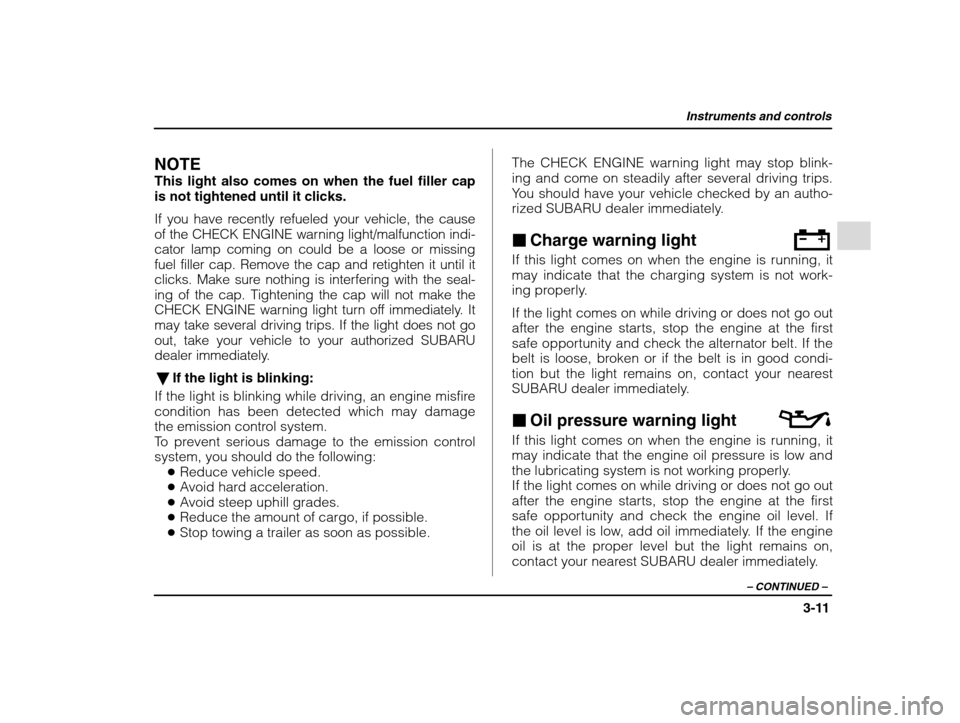
Instruments and controls
3-11
– CONTINUED –
NOTE This light also comes on when the fuel filler cap is not tightened until it clicks.
If you have recently refueled your vehicle, the cause
of the CHECK ENGINE warning light/malfunction indi-
cator lamp coming on could be a loose or missing
fuel filler cap. Remove the cap and retighten it until it
clicks. Make sure nothing is interfering with the seal-
ing of the cap. Tightening the cap will not make the
CHECK ENGINE warning light turn off immediately. It
may take several driving trips. If the light does not go
out, take your vehicle to your authorized SUBARU
dealer immediately.
� If the light is blinking:
If the light is blinking while driving, an engine misfire
condition has been detected which may damage
the emission control system.
To prevent serious damage to the emission control
system, you should do the following: �Reduce vehicle speed.
� Avoid hard acceleration.
� Avoid steep uphill grades.
� Reduce the amount of cargo, if possible.
� Stop towing a trailer as soon as possible. The CHECK ENGINE warning light may stop blink-ing and come on steadily after several driving trips.
You should have your vehicle checked by an autho-
rized SUBARU dealer immediately.
� Charge warning light
If this light comes on when the engine is running, itmay indicate that the charging system is not work-
ing properly. If the light comes on while driving or does not go out
after the engine starts, stop the engine at the first
safe opportunity and check the alternator belt. If the
belt is loose, broken or if the belt is in good condi-
tion but the light remains on, contact your nearest
SUBARU dealer immediately. � Oil pressure warning light
If this light comes on when the engine is running, it
may indicate that the engine oil pressure is low and
the lubricating system is not working properly.If the light comes on while driving or does not go out
after the engine starts, stop the engine at the first
safe opportunity and check the engine oil level. If
the oil level is low, add oil immediately. If the engine
oil is at the proper level but the light remains on,
contact your nearest SUBARU dealer immediately.
Page 232 of 390
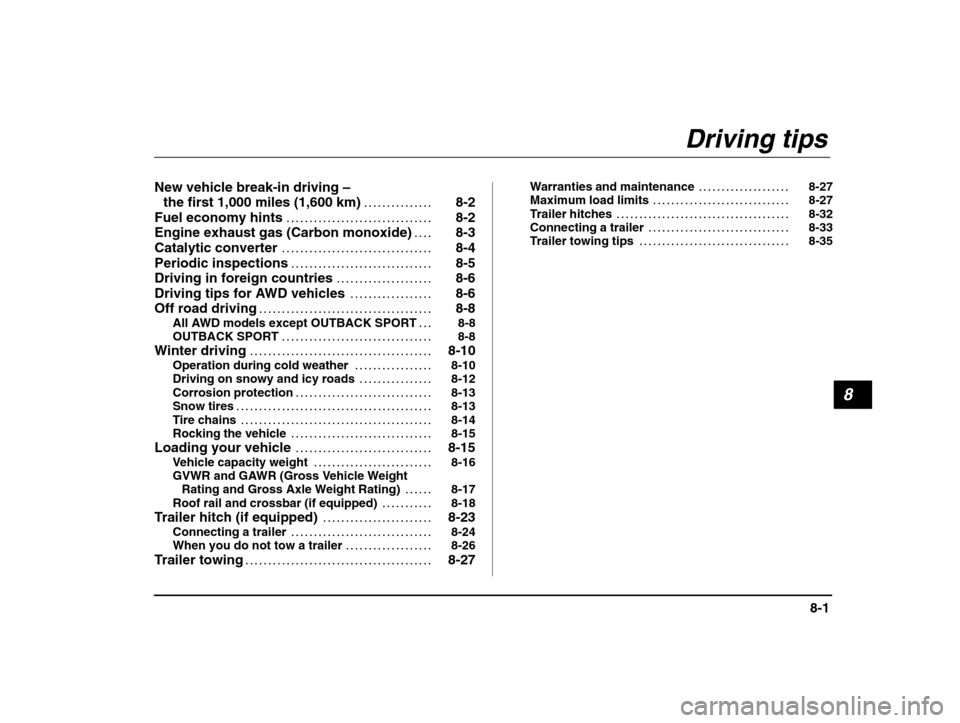
8
8-1
– CONTINUED –
New vehicle break-in driving –
the first 1,000 miles (1,600 km) 8-2 . . . . . . . . . . . . . . .
Fuel economy hints 8-2 . . . . . . . . . . . . . . . . . . . . . . . . . . . . . . . .
Engine exhaust gas (Carbon monoxide) 8-3 . . . .
Catalytic converter 8-4 . . . . . . . . . . . . . . . . . . . . . . . . . . . . . . . . .
Periodic inspections 8-5 . . . . . . . . . . . . . . . . . . . . . . . . . . . . . . .
Driving in foreign countries 8-6 . . . . . . . . . . . . . . . . . . . . .
Driving tips for AWD vehicles 8-6 . . . . . . . . . . . . . . . . . .
Off road driving 8-8 . . . . . . . . . . . . . . . . . . . . . . . . . . . . . . . . . . . . . .
All AWD models except OUTBACK SPORT 8-8 . . .
OUTBACK SPORT 8-8 . . . . . . . . . . . . . . . . . . . . . . . . . . . . . . . . .
Winter driving 8-10 . . . . . . . . . . . . . . . . . . . . . . . . . . . . . . . . . . . . . . . .
Operation during cold weather 8-10 . . . . . . . . . . . . . . . . .
Driving on snowy and icy roads 8-12 . . . . . . . . . . . . . . . .
Corrosion protection 8-13 . . . . . . . . . . . . . . . . . . . . . . . . . . . . . .
Snow tires 8-13
. . . . . . . . . . . . . . . . . . . . . . . . . . . . . . . . . . . . . . . . . . .
Tire chains 8-14
. . . . . . . . . . . . . . . . . . . . . . . . . . . . . . . . . . . . . . . . . .
Rocking the vehicle 8-15 . . . . . . . . . . . . . . . . . . . . . . . . . . . . . . .
Loading your vehicle 8-15 . . . . . . . . . . . . . . . . . . . . . . . . . . . . . .
Vehicle capacity weight 8-16 . . . . . . . . . . . . . . . . . . . . . . . . . .
GVWR and GAWR (Gross Vehicle Weight
Rating and Gross Axle Weight Rating) 8-17 . . . . . .
Roof rail and crossbar (if equipped) 8-18 . . . . . . . . . . .
Trailer hitch (if equipped) 8-23 . . . . . . . . . . . . . . . . . . . . . . . .
Connecting a trailer 8-24 . . . . . . . . . . . . . . . . . . . . . . . . . . . . . . .
When you do not tow a trailer 8-26 . . . . . . . . . . . . . . . . . . .
Trailer towing 8-27 . . . . . . . . . . . . . . . . . . . . . . . . . . . . . . . . . . . . . . . . . Warranties and maintenance 8-27
. . . . . . . . . . . . . . . . . . . .
Maximum load limits 8-27 . . . . . . . . . . . . . . . . . . . . . . . . . . . . . .
Trailer hitches 8-32 . . . . . . . . . . . . . . . . . . . . . . . . . . . . . . . . . . . . . .
Connecting a trailer 8-33 . . . . . . . . . . . . . . . . . . . . . . . . . . . . . . .
Trailer towing tips 8-35 . . . . . . . . . . . . . . . . . . . . . . . . . . . . . . . . .
Driving tips
Page 248 of 390
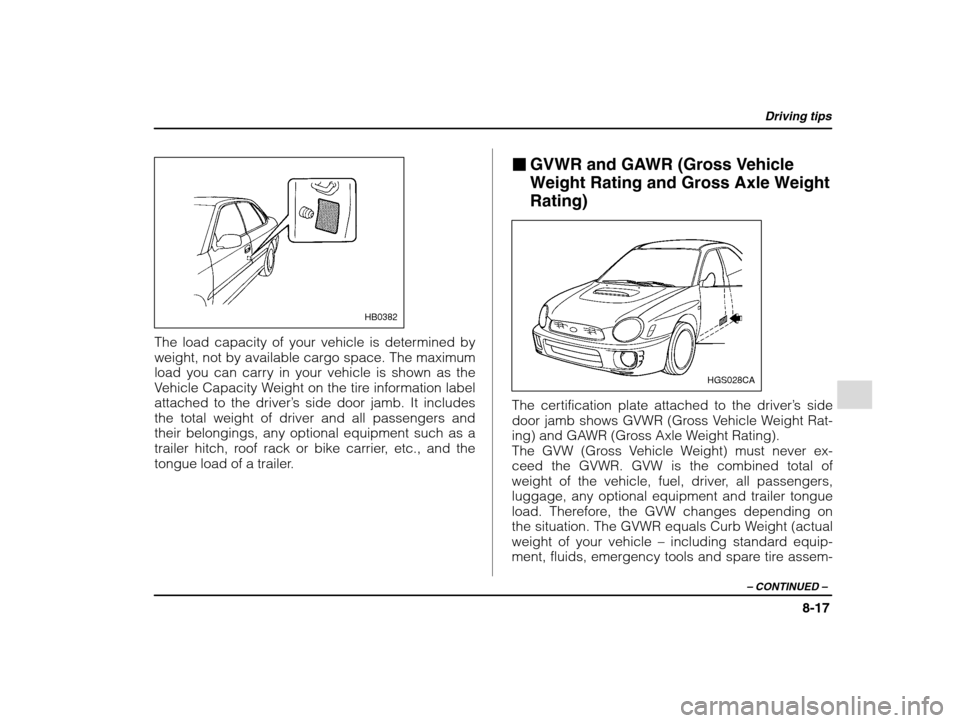
Driving tips
8-17
– CONTINUED –
HB0382
The load capacity of your vehicle is determined by
weight, not by available cargo space. The maximum
load you can carry in your vehicle is shown as the
Vehicle Capacity Weight on the tire information label
attached to the driver ’s side door jamb. It includes
the total weight of driver and all passengers and their belongings, any optional equipment such as a
trailer hitch, roof rack or bike carrier, etc., and the
tongue load of a trailer. �
GVWR and GAWR (Gross Vehicle
Weight Rating and Gross Axle WeightRating)
HGS028CA
The certification plate attached to the driver ’s side
door jamb shows GVWR (Gross Vehicle Weight Rat-
ing) and GAWR (Gross Axle Weight Rating).
The GVW (Gross Vehicle Weight) must never ex- ceed the GVWR. GVW is the combined total of
weight of the vehicle, fuel, driver, all passengers,
luggage, any optional equipment and trailer tongue
load. Therefore, the GVW changes depending on
the situation. The GVWR equals Curb Weight (actual weight of your vehicle – including standard equip-
ment, fluids, emergency tools and spare tire assem-
Page 254 of 390
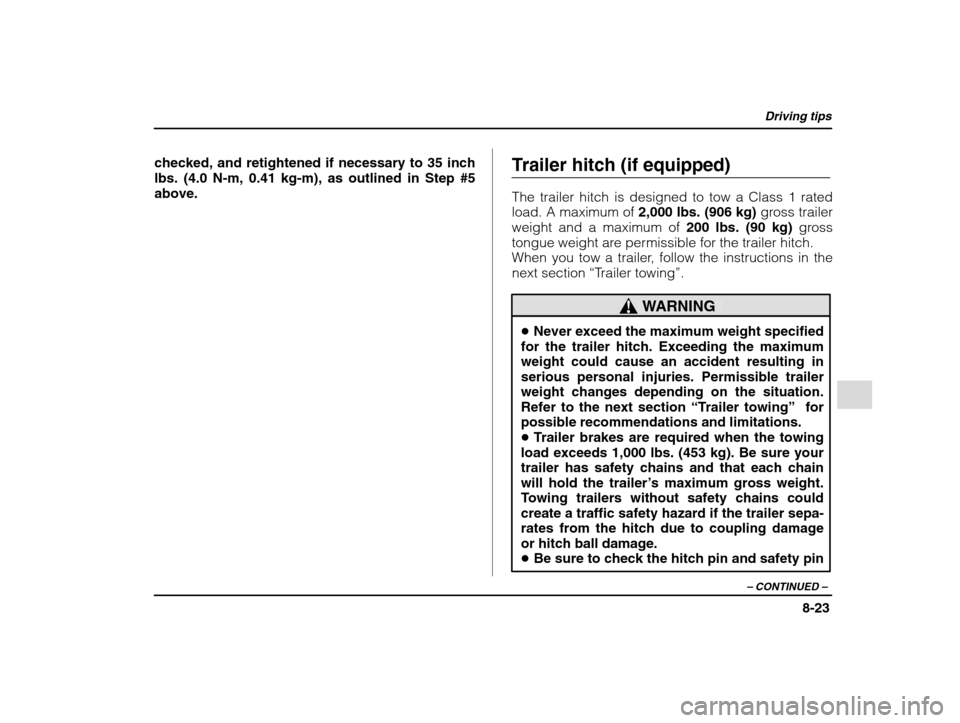
Driving tips
8-23
– CONTINUED –
checked, and retightened if necessary to 35 inch
lbs. (4.0 N-m, 0.41 kg-m), as outlined in Step #5above. Trailer hitch (if equipped) The trailer hitch is designed to tow a Class 1 rated
load. A maximum of
2,000 lbs. (906 kg) gross trailer
weight and a maximum of 200 lbs. (90 kg) gross
tongue weight are permissible for the trailer hitch.
When you tow a trailer, follow the instructions in the next section “Trailer towing ”.
WARNING
�Never exceed the maximum weight specified
for the trailer hitch. Exceeding the maximum weight could cause an accident resulting inserious personal injuries. Permissible trailerweight changes depending on the situation.Refer to the next section “Trailer towing ” for
possible recommendations and limitations.� Trailer brakes are required when the towing
load exceeds 1,000 lbs. (453 kg). Be sure yourtrailer has safety chains and that each chainwill hold the trailer ’s maximum gross weight.
Towing trailers without safety chains could create a traffic safety hazard if the trailer sepa- rates from the hitch due to coupling damageor hitch ball damage.� Be sure to check the hitch pin and safety pin
Page 255 of 390

Driving tips
8-24
for positive locking placement before towing a
trailer. If the ball mount comes off the hitch re-
ceiver, the trailer could get loose and create atraffic safety hazard.�Use only the ball mount supplied with this
hitch. Use the hitch only as a weight carrying
hitch. Do not use with any type of weight dis- tributing hitch.
� Connecting a trailer
1. Remove the receiver cover from the hitch receiv-
er tube. Then insert the ball mount into the hitch re- ceiver tube.
2. Insert the hitch pin into the hole on the hitch re-
ceiver tube so that the pin passes through the ballmount.
HB8018BA
3. Insert the safety pin into the hitch pin securely.
HB8019BA
Page 256 of 390
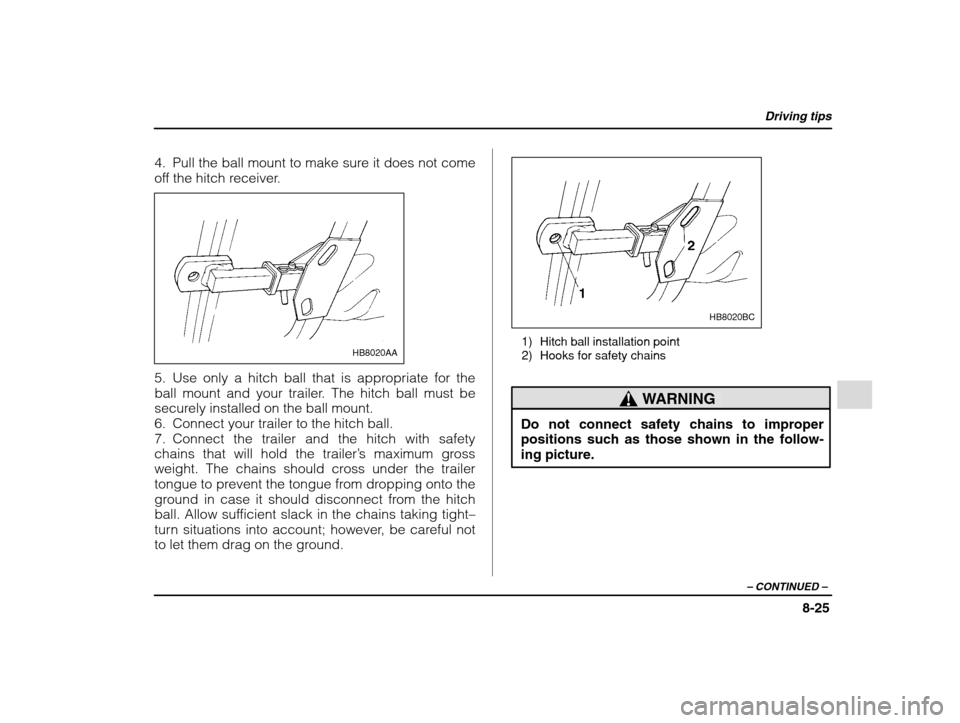
Driving tips
8-25
– CONTINUED –
4. Pull the ball mount to make sure it does not come
off the hitch receiver.
HB8020AA
5. Use only a hitch ball that is appropriate for the
ball mount and your trailer. The hitch ball must be
securely installed on the ball mount.
6. Connect your trailer to the hitch ball.
7. Connect the trailer and the hitch with safetychains that will hold the trailer ’s maximum gross
weight. The chains should cross under the trailer
tongue to prevent the tongue from dropping onto the
ground in case it should disconnect from the hitch
ball. Allow sufficient slack in the chains taking tight –
turn situations into account; however, be careful not
to let them drag on the ground.
HB8020BC
1) Hitch ball installation point
2) Hooks for safety chains
WARNING
Do not connect safety chains to improper positions such as those shown in the follow- ing picture.
Page 257 of 390
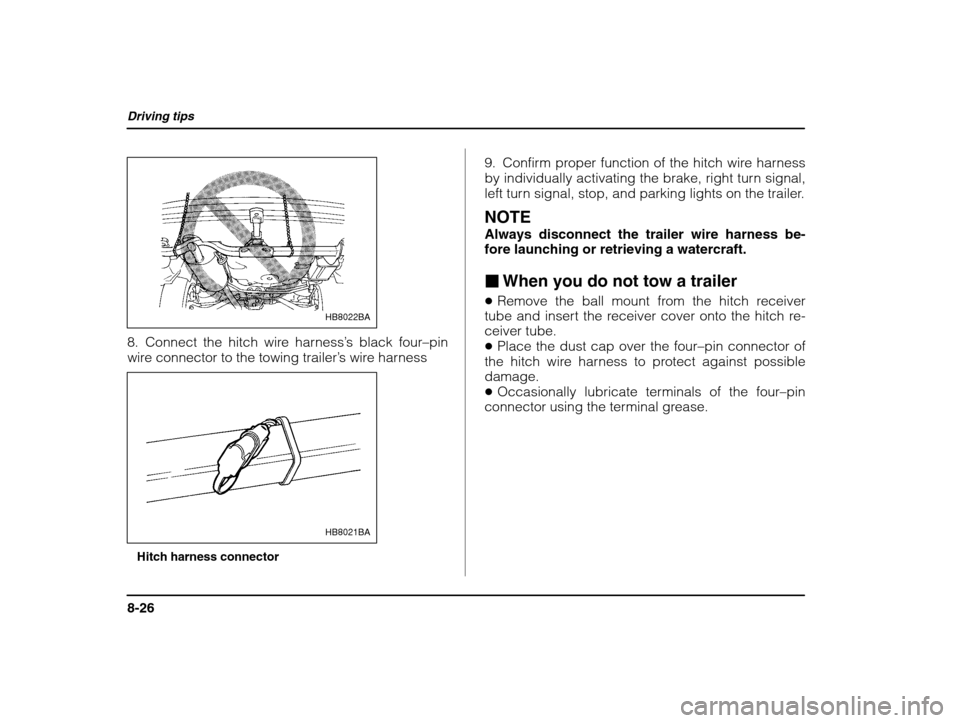
Driving tips
8-26
HB8022BA
8. Connect the hitch wire harness’s black four –pin
wire connector to the towing trailer ’s wire harness
HB8021BA
Hitch harness connector 9. Confirm proper function of the hitch wire harness
by individually activating the brake, right turn signal,
left turn signal, stop, and parking lights on the trailer. NOTE Always disconnect the trailer wire harness be- fore launching or retrieving a watercraft. �
When you do not tow a trailer
� Remove the ball mount from the hitch receiver
tube and insert the receiver cover onto the hitch re- ceiver tube.� Place the dust cap over the four –pin connector of
the hitch wire harness to protect against possibledamage. � Occasionally lubricate terminals of the four –pin
connector using the terminal grease.
Page 258 of 390

Driving tips
8-27
– CONTINUED –
Trailer towing
Your car is designed and intended to be used pri-
marily as a passenger-carrying vehicle. Towing a
trailer puts additional loads on your car ’s engine, dri-
vetrain, brakes, tires and suspension and has an
adverse effect on fuel economy.
If you do decide to tow a trailer, your safety and sat-
isfaction depend upon proper use of correct equip-
ment and cautious operation of your vehicle. Seekthe advice of your SUBARU dealer to assist you in
purchasing a hitch and other necessary towing
equipment appropriate for your vehicle. In addition,
be sure to follow the instructions on correct installa-
tion and use provided by the trailer and other towing
equipment manufacturers.
SUBARU assumes no responsibility for injuries or
vehicle damage that result from trailer towing equip-
ment, or from any errors or omissions in the instruc- tions accompanying such equipment or for your fail-
ure to follow the proper instructions. � Warranties and maintenance
SUBARU warranties do not apply to vehicle damage or malfunction caused by trailer towing. If you use
your vehicle to tow a trailer, more frequent mainte-
nance will be required due to the additional load. (Refer to
“Maintenance schedule under severe driv-
ing conditions ” in the “Warranty and Maintenance
Booklet”.)
Under no circumstances should a trailer be towedwith a new vehicle or a vehicle with any new power-
train component (engine, transmission, differential, wheel bearings, etc.) for the first 1,000 miles (1,600 km) of driving. � Maximum load limits
WARNING
Never exceed the maximum load limits ex-
plained below. Exceeding the maximum loadlimits could cause personal injury and/or ve-hicle damage.
CAUTION
�Adequate size trailer brakes are required
when the trailer and its cargo exceed 1,000 lbs (453 kg) total weight. � Before towing a trailer, check the trailer total
weight, GVW, GAWs and tongue load. Make sure the load and its distribution in your
vehicle and trailer are acceptable.